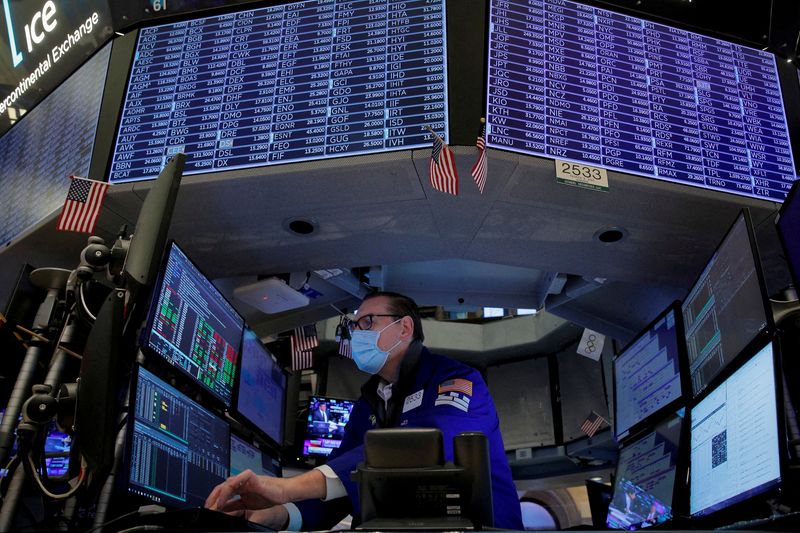By Geoffrey Smith
Investing.com -- The Federal Reserve is set to raise interest rates by an expected 75 basis points, in what would be the biggest rate hike in nearly 30 years. The European Central Bank calls an emergency meeting to try to stop a blowout in Eurozone bond spreads. U.S. retail sales for May are due, and Chinese retail sales and industrial output data show an improvement in the economy as major lockdowns in Shanghai and elsewhere were lifted. Bitcoin bounces off support at $20,000. Apple and Disney spend big on sports rights, and oil falls after a modest rise in U.S. stockpiles, but the outlook remains difficult, according to the International Energy Agency. Here's what you need to know in financial markets on Wednesday, June 15.
1. Fed set for biggest rate hike since 1994
The Federal Reserve is expected to raise the target range for Fed Funds by 75 basis points to 1.5%-1.75%, in what would be its biggest rate hike in 28 years.
Investors have rapidly repriced their expectations in the wake of Friday’s inflation report for May, in which the consumer price index rose to a fresh 4-decade high of 8.6%. Among other things, the Fed will be weighing the potential benefits of a more aggressive move now against the negative effect it may have on the credibility of its forward guidance, which pointed clearly to a half-point hike until the start of its customary pre-meeting blackout period.
The Fed’s decision at 2 PM ET (1800 GMT) will also take into account the latest signs of momentum in consumer spending. Retail sales data for May are due at 8:30 AM ET.
2. Panic on the streets of Frankfurt
The European Central Bank called an emergency meeting in an effort to stem the explosion of volatility in the Eurozone’s bond markets.
Bond spreads, a typical barometer of financial stress in the Eurozone and a reflection of market fears of countries being forced out of the currency union, widened sharply after the ECB failed to give any information on how it aimed to contain spreads as it embarks on its first major tightening of policy in a decade.
Bond markets reacted favorably to the news, with the Italy 10-Year yield falling 19 basis points by 6:05 AM ET to trade at 4.03%. It broke through 4% for the first time in over eight years on Monday. That’s a level that Italy will struggle to sustain unless its growth accelerates sustainably from what it has registered so far since joining the eurozone in 1999. The euro, meanwhile, rose 0.7% to $1.0482.
3. Stocks set for a bounce; Sports rights deals eyed
U.S. stock markets are set to open higher later, but everything will depend on the Fed’s decision and, before that, on the retail sales print.
By 6:10 AM ET, Dow Jones futures were up 133 points, or 0.4%, on course to snap a five-day losing streak. S&P 500 futures were up 0.5%, while Nasdaq 100 futures were up 0.7%.
The tone was also helped by better-than-expected retail sales and industrial production data out of China overnight, which encouraged hopes that the country is getting on top of its lingering problems with COVID-19.
Stocks likely to be in focus later include Apple (NASDAQ:AAPL), which agreed to pay at least $2.5 billion for streaming rights to U.S. Major League Soccer on Tuesday, while Walt Disney (NYSE:DIS) will also be in focus after agreeing to pay $3 billion to keep broadcasting Indian Premier League cricket. It lost the contest for streaming rights to a joint venture of Paramount Global and India’s Reliance Industries.
4. Bitcoin bounces at $20k as MicroStrategy fails to calm nerves
Bitcoin slumped another 9% to hit a new 18-month low, before bouncing – without conviction - off the $20,000 level.
‘Digital gold’ has now lost 33% in the last seven days, a fresh blow to its supporters’ claims of its ability to act as a store of value.
Ethereum meanwhile fell another 10.5% and is now down some 43% over the last week, as the collapse of crypto lender Celsius Network continues to send shockwaves through the ecosystem of tokens linked in one way or another to the Ethereum blockchain.
MicroStrategy (NASDAQ:MSTR) CEO Michael Saylor had said on Tuesday that his company - a de facto levered crypto hedge fund – had enough extra collateral to forestall any margin call on a $205 million loan which the company had previously said would trigger at a price of $22,000.
5. Oil lower as inventory rise outweighs IEA warning
Crude oil prices eased a little, despite a fresh warning from the International Energy Agency that demand is likely to outstrip supply again next year.
The IEA pointed to a possible prolonged fall in Russian output that may be only partly offset by production growth in the Middle East and the U.S.
That followed a warning from OPEC on Tuesday in its monthly oil report that western sanctions on Russia would likely lead to the so-called OPEC+ bloc pumping less than forecast this year.
By 6:30 AM ET, U.S. crude futures were down 1.2% at $117.53 a barrel, while Brent was down 1.0% at $119.98 a barrel. The U.S. government publishes inventory data at 10:30 AM ET, a day after the American Petroleum Institute reported a surprising but small rise in crude stockpiles.
